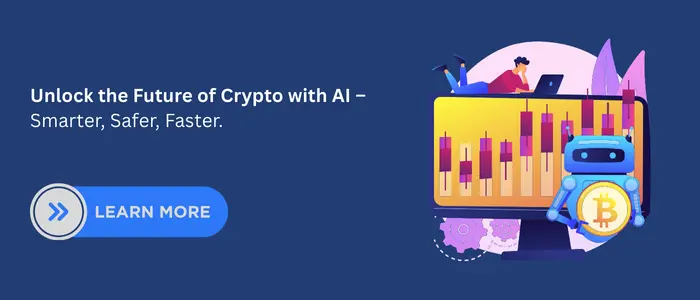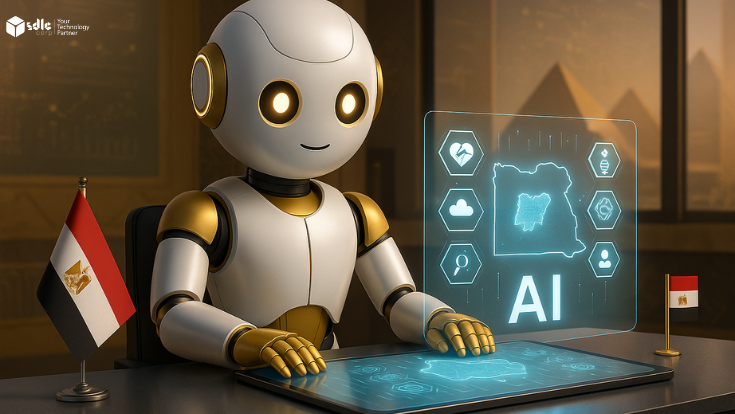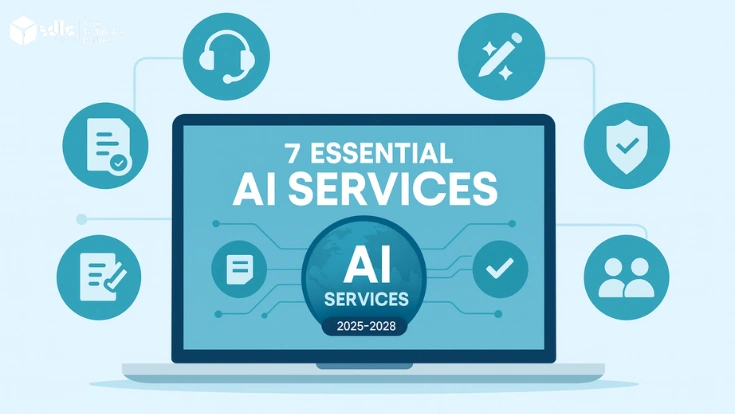Introduction
Generative AI for cryptocurrency is changing the way we look at money in the digital world. Blockchain already gave us decentralization, transparency, and a new way of moving value without banks. However, when artificial intelligence is added into the mix, things become even more interesting. Moreover, Generative AI introduces smarter predictions, greater automation, and stronger safety into crypto.
According to reports, the Generative AI in Cryptocurrency Market could be worth around 1 billion dollars by 2025, and it may grow to over 12 billion dollars by 2034. This rapid growth shows that, more people, businesses, and investors are turning to AI-powered tools for trading, security, and managing crypto. In addition, the rising demand proves that AI is no longer an optional tool but a core driver of progress.
Use of Generative AI in Cryptocurrency Platforms
Cryptocurrency platforms process large volumes of transactional and market data in real time. Generative AI can assist by summarising blockchain activity, generating analytical reports, and supporting user communication. Many teams explore Generative AI development services to build models that operate alongside decentralised systems while respecting transparency and data integrity requirements.
1.Market Overview
The Generative AI in Cryptocurrency Market is growing fast because both everyday traders and big institutions want smarter tools. Software companies and service providers are rushing to build systems that make crypto safer and easier to manage.
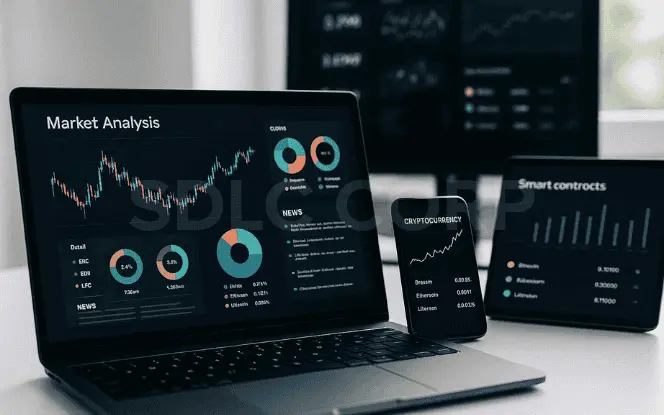
Where AI is used most in crypto today:
- Trading and investment decisions.
- Fraud detection and AI-driven crypto security.
- Smart contracts that run safely.
- Mining that uses less energy.
- Market and social media analysis.
Because the demand is coming from both individuals and big players, the growth is steady worldwide.
2.Growth Drivers
There are several reasons why AI and crypto are coming together so quickly. First of all, more people are using cryptocurrency, and as businesses accept digital currencies, smarter systems are needed to keep things running smoothly. Moreover, the high computing needs of both industries make them a natural fit since GPUs and TPUs power mining as well as AI. At the same time, security threats are rising, and constant hacks and scams are pushing the need for AI-powered fraud detection systems that can react faster than humans.
In addition, the growth of decentralized finance (DeFi) is creating demand for smart automation, and AI is stepping in to handle complex transactions. Furthermore, institutions like banks and funds are moving into blockchain, and AI tools are helping them manage risks with more precision. As a result, AI in crypto isn’t slowing down; instead, it is expanding rapidly, driving both innovation and trust in the financial ecosystem.

3.A Short History of AI in Cryptocurrency
AI has been around in finance for years. In traditional markets, it powered algorithmic trading. In crypto, it started small with simple trading bots. Over time, as blockchain data grew, AI found new jobs.
How AI grew in crypto:
- Early bots reacted to price moves.
- Machine learning models began predicting market changes.
- Fraud detection systems started protecting wallets and exchanges.
- Mining companies used AI to cut energy waste.
- AI began checking smart contracts before launch.
So, what started as an optional tool has now become a must-have.
4.Applications of Generative AI in Crypto
Generative AI is changing the way cryptocurrency works by making systems smarter, safer, and faster. Moreover, from trading and fraud detection to smart contracts and mining, AI is bringing practical solutions that improve efficiency and build trust in blockchain.
4.1 AI in Trading and Investment
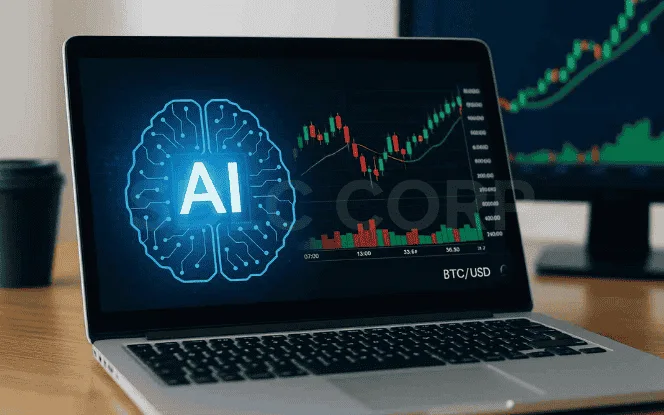
Crypto trading is exciting but also risky. Prices jump fast. Generative AI helps traders by making sense of huge amounts of data and offering better predictions.
How AI helps traders:
- Looks at charts, social media, and news all at once.
- Predicts where prices might go.
- Runs bots that trade instantly, without delay.
- Creates “what if” market scenarios so traders can test strategies.
In simple words, crypto trading AI makes trading smarter and reduces guesswork.
4.2 AI in Risk Management and Fraud Detection

Fraud is one of crypto’s biggest problems. Since transactions are anonymous, criminals can take advantage. AI makes the system safer.
Ways AI improves crypto security:
- Flags unusual wallet activity in real time.
- Automates KYC and AML checks for compliance.
- Builds risk profiles to spot dangerous accounts.
- Detects patterns linked to scams or laundering.
Because of this, AI-driven crypto security builds trust for both small traders and large exchanges.
4.3 AI in Smart Contracts
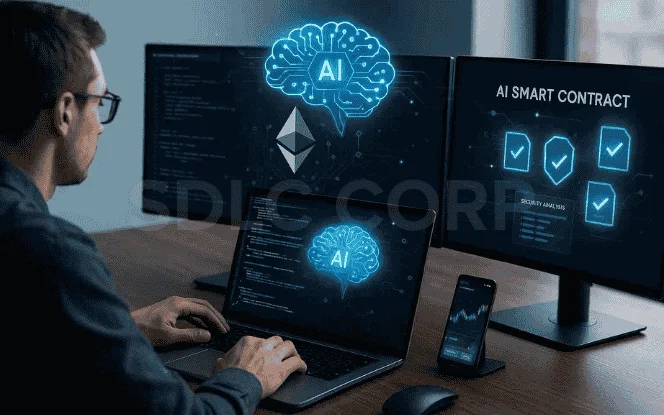
Smart contracts are the backbone of decentralized apps. They run on code, but if the code has mistakes, money can be lost. AI helps make them stronger.
How AI improves smart contracts:
- Writes and checks code.
- Finds weaknesses before launch.
- Tests contracts in different situations.
- Adjusts contract terms during busy network times.
This means contracts run smoother, faster, and with fewer risks.
4.4 AI in Crypto Mining
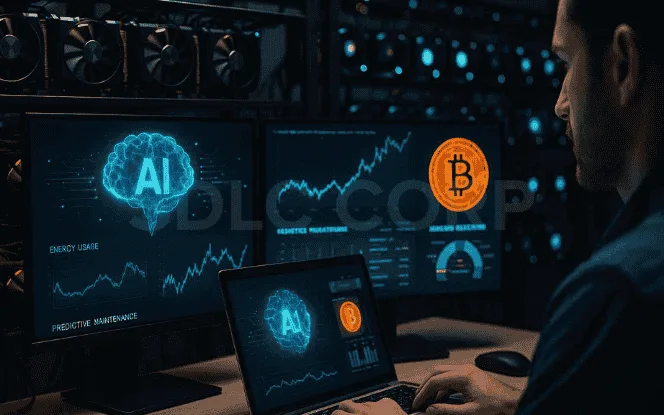
Mining is expensive and energy-heavy. AI makes it smarter and cheaper.
AI benefits in mining:
- Predicts when machines need fixing.
- Cuts electricity use.
- Shifts resources based on demand.
- Helps mining firms move toward AI-powered services.
As a result, AI in crypto mining makes the process more sustainable and profitable.
4.5 AI in Sentiment and Market Analysis
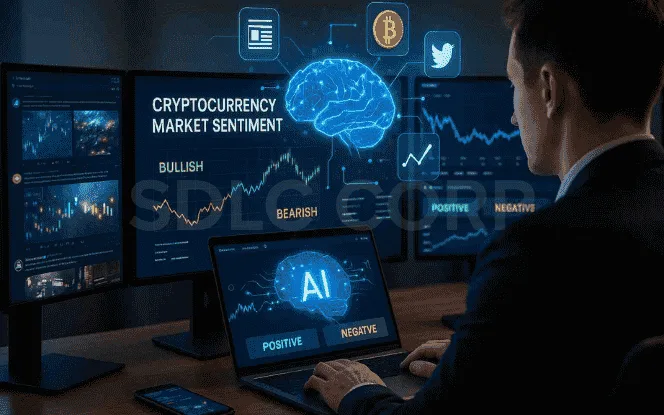
Crypto prices are often driven by hype, news, and social media. AI can read and process this information faster than people.
AI’s role in sentiment analysis:
- Spots bullish or bearish moods early.
- Scans millions of posts and news items instantly.
- Gives traders real-time market mood reports.
- Helps companies see how people feel about crypto.
This way, traders can make moves before the market reacts fully.
5.Benefits of Generative AI in Cryptocurrency
The advantages of AI in crypto are clear.
- Smarter decisions: Predictions are more accurate.
- Faster actions: Bots trade in seconds.
- Safer systems: AI finds scams quickly.
- Lower costs: Mining and contracts use less energy.
- Personalized advice: Investors get tailored tips.
- Easier compliance: AI helps exchanges follow rules.
Because of these benefits, adoption is happening everywhere.
6.Real-World Use Cases
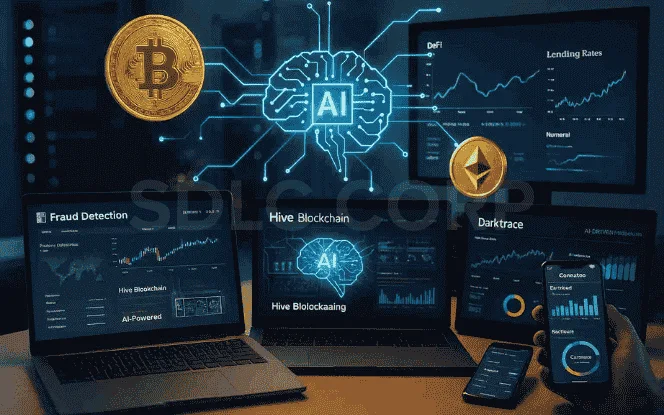
Generative AI is already being used in the cryptocurrency world, and its influence is becoming more visible every day. For example, Binance uses AI to monitor trading patterns and stop fraud, which makes exchanges more secure and trustworthy. Meanwhile, Coinbase applies AI to read market sentiment, helping traders understand shifts in public opinion much faster than traditional tools. In addition, Hive Blockchain has moved from traditional mining to AI-powered services, showing how companies can adapt and grow by embracing new technologies.
Moreover, DeFi apps are now using AI to set lending rates fairly, giving users better financial opportunities in decentralized markets. At the same time, Darktrace protects blockchain firms with advanced AI cybersecurity, reducing the risk of hacks and other digital threats. Finally, Numerai operates a hedge fund that combines AI and cryptocurrency, which proves how powerful this partnership can be. As a result, these real-world examples demonstrate that AI in crypto is no longer a concept for the future—it is already here, practical, and actively shaping the industry.
7. Risk Analysis and Market Monitoring
Volatility and security risks are constant concerns in cryptocurrency ecosystems. Generative AI can help analyse market signals, draft risk summaries, and highlight unusual patterns in trading behaviour.
In these cases, a Generative AI consulting company may support the evaluation of model accuracy, data sources, and safeguards to reduce misleading or speculative outputs.
8.Future of AI in Crypto Trading Bots

Trading bots are getting smarter every year. They used to be simple, but now AI makes them adaptive and quick.
What’s new with AI bots:
- Learn from market changes in real time.
- Read news and social media with natural language tools.
- React to sentiment shifts instantly.
- Manage risk by rebalancing portfolios.
Soon, bots may work like digital assistants, guiding traders 24/7.
9.AI and Crypto in Emerging Economies
Countries in Africa and Latin America are using crypto fast. AI helps here too by solving unique problems.
AI roles in emerging markets:
- Makes cross-border payments safer.
- Offers micro-investment options for small savers.
- Brings DeFi to people without bank accounts.
- Stops scams in mobile wallets.
So, AI is not just for big investors. It’s also helping regular people in developing nations.
10.Benefits for Regulators and Policymakers
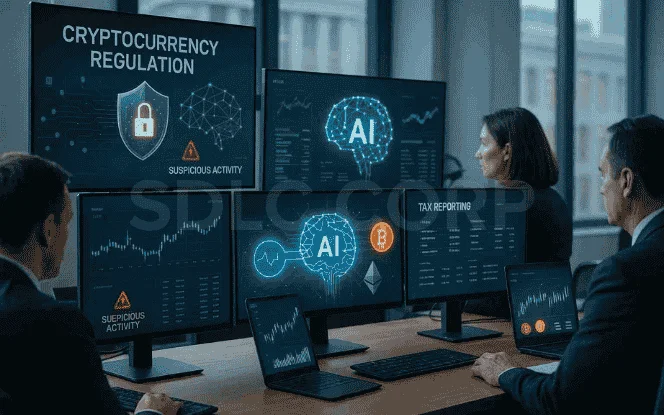
Governments need to strike a balance between freedom and control, and AI helps them achieve this goal. Moreover, regulators gain powerful tools that make monitoring suspicious exchange activity faster and more accurate. In addition, AI supports compliance by strengthening AML and KYC enforcement, which are crucial for protecting financial systems.
Therefore, it becomes easier to spot price manipulation and market abuse that would otherwise go unnoticed. As a result, authorities can react quickly and ensure that investors remain protected.
However, regulation is not only about catching criminals; it is also about building trust in cryptocurrency markets. Thus, AI helps tax authorities better understand crypto data, ensuring fair practices without overwhelming manual work. Ultimately, AI provides governments with the ability to maintain safety while still allowing innovation to grow, creating a healthier and more sustainable crypto ecosystem.
11.Integration with Other Technologies s
AI works best when combined with other modern tech.
Key connections:
- Web3: Makes decentralized apps smarter.
- Metaverse: Powers transactions in virtual worlds.
- IoT: Lets devices make small crypto payments.
- Quantum computing: Builds stronger future security.
Together, these create a strong digital ecosystem.
12.Ethical and Regulatory Considerations
Even though AI is highly useful in cryptocurrency, certain risks remain. One major concern is the misuse of AI in scams, where criminals could create fake trading signals or automated bots to trick investors. Moreover, the lack of transparency in algorithms makes it difficult for users to understand how decisions are made. As a result, people may place blind trust in systems that do not always serve their best interests.
In addition, privacy is another key issue, since AI tools often handle sensitive user data and financial records. Without proper safeguards, however, this information could be exposed or misused. Therefore, there is a growing demand for global rules and regulations that ensure AI is applied responsibly in the crypto space. Thus, balancing innovation with safety is essential to create an environment where technology can grow while protecting users at the same time.
13. Model Development and Technical Oversight
Implementing generative AI in cryptocurrency environments requires careful design and ongoing monitoring. Models must handle fast-changing data and avoid introducing false assumptions. Some organisations choose to hire generative AI developers to build, test, and maintain these systems, ensuring they align with blockchain protocols and operational requirements.
14. Integration with Broader AI and Analytics Systems
Generative AI tools are often part of a larger stack that includes fraud detection, price prediction, and user analytics. Integrating these components requires stable infrastructure and clear data pipelines. Cryptocurrency platforms may rely on AI development services to connect generative models with existing systems while maintaining performance, security, and auditability.
Conclusion
Generative AI for cryptocurrency is more than just another tech trend; it represents a major shift in how finance operates. From crypto trading AI that predicts market moves with greater accuracy, to AI-driven crypto security that protects against fraud, the impact is already visible. Moreover, AI is transforming the way smart contracts are built, making them safer and more reliable. In addition, AI in DeFi is creating automated financial services that are more accessible to users worldwide.
However, this shift is not only about technology but also about the way people interact with money. As a result, investors, developers, and regulators are beginning to see AI as a vital tool for building trust in digital assets. Therefore, adopting AI-powered crypto tools today gives both individuals and institutions a head start in a financial system that is quickly becoming smarter and more efficient. Ultimately, the future of crypto will not just be decentralized—it will also be intelligent, adaptive, and secure, thanks to the power of generative AI.
FAQ'S
What is Generative AI in cryptocurrency?
Generative AI in cryptocurrency means using smart computer programs that can create new ideas, predictions, or solutions for the crypto world. For example, it can write better smart contracts, predict market moves, and even detect fraud. In simple words, it helps crypto become smarter and safer.
How does AI improve crypto trading?
AI improves trading by reading huge amounts of data that humans can’t handle quickly. It looks at price charts, news, and even social media posts. Then it predicts what might happen next. Some AI-powered trading bots can even place trades automatically, helping investors save time and reduce mistakes.
Is AI safe to use in cryptocurrency?
Yes, AI makes crypto safer in many ways. It can track unusual activity in wallets, block suspicious transactions, and help exchanges follow KYC and AML rules. While no system is 100% safe, AI-driven crypto security is much stronger than manual checks alone.
What are real-world examples of AI in crypto?
Big platforms already use AI today. For example, Binance uses AI to stop fraud, Coinbase uses AI to study market sentiment, and DeFi apps use AI to set fair lending rates. Mining companies also use AI to cut energy costs. These examples show that AI is not just theory but real practice.
What is the future of AI in cryptocurrency?
The future looks bright. AI will make decentralized apps smarter, trading bots more reliable, and security systems stronger. It may even help build stablecoins that don’t crash during market swings. In short, the future of crypto with AI will be safer, faster, and more personal for both individuals and businesses.


